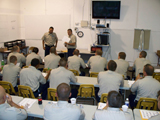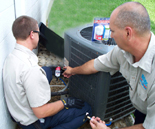
Steve Helms (right), Brothers Air, Heat & Plumbing’s service manager, awards Kenny Indresano, service tech, a Nexstar training certificate at one of many periodic service tech seminars the 30-year-old HVAC service contractor holds throughout the year. (Photo courtesy of Brothers Air, Heat & Plumbing.) (Click on the image for an enlarged view.)
When the recession hit hard with a great potential to lose customers who couldn’t afford to replace leaking equipment, Brothers policy of using sealants positioned them to not only retain customers and good will, but add to profitability. “Many of our customers are really suffering financially from the recession, so offering this option is really appreciated,” said Steve Helms, service manager.
The 30-year-old contractor spends tens of thousands of dollars training its techs annually in many HVAC aspects including such programs as North American Technician Excellence (NATE), Arlington, Va.; Nexstar, White Bear Lake, Minn.; and National Comfort Institute (NCI), Sheffield Lake, Ohio. Therefore, Helms jumped at the opportunity when Cliplight Mfg., Toronto, which pioneered HVAC refrigeration vacuum-packed sealant technology, offered an onsite training workshop at its Brothers Rock Hill, S.C., headquarters conducted by Paul Appler, Cliplight’s director of research and the inventor of the Super Seal line of sealants. “When you get training from the person that developed the product, that’s about the highest level you could possibly get, plus several of our technicians have contacted him since and have gotten immediate answers,” said Helms.
The training was also invaluable because, although Brothers made a serious commitment to use sealants such as Cliplight’s Super Seal HVACR exclusively, several earlier applications hadn’t been successful due to what Helms now believes may have been failures to rid the systems of moisture or decisions to seal leak holes that were larger than the manufacturer’s suggested size of 300 microns (the diameter of a human hair).
Consequently, Brothers has established the policy that sealants are used in systems that have leaked only 10 percent or so of their charge over a four-week period. Helms contends that larger losses indicate a potential for a leak or leaks too large for sealing. Since eliminating system moisture is critical to sealant success, Brothers is using Cliplight’s new Ultra Pack, which combines Super Seal HVACR and the new DRY R moisture remover in one package. Introduced in 2008, DRY R chemically disassembles moisture and changes it to a low viscosity, residue free, non-oily liquid that is highly soluble with the system’s oil and flows freely throughout the system without chemically attaching to commonly-found AC/R system contaminants. Eliminating moisture not only prepares the system for sealing, but it also prevents further acid formation, resultant corrosion, and other problems associated with moisture.
Since establishing criteria for which systems qualify for sealants, training its service techs, and using a moisture eliminator if applicable, Brothers now has more than 500 applications working smoothly in the field since January 2009.
Training in all aspects of HVAC is so important to Brothers that it employs a full-time technical trainer, Bobby Nasekos, who conducts individual field training with technicians as well as for the entire service department in group training sessions on a wide variety of HVAC subjects.

Bobby Nasekos (right), Brothers Air, Heat & Plumbing’s full-time technical trainer, many times does on-site training such as this Super Seal sealant application of a central a/c unit by Rodney Sullivan (left), service tech. (Photo courtesy of Brothers Air, Heat & Plumbing.) (Click on the image for an enlarged view.)
MARKETING SEALANTS
Presenting sealants properly to customers is almost as important as following the necessary steps to applying them, according to Helms. All service techs are trained for on-site sales presentations and outfitted with flat-rate price books on all HVAC services to demonstrate accuracy and integrity when explaining different options for servicing and/or repairing equipment.On systems slightly low on refrigerant, the service tech typically tops it off, and then performs a leak search with an electronic leak detector from TIF Instruments, Owatonna, Minn., or Yellow Jacket Products, Bloomington, Minn., which is built into the refrigerant flat-pricing. The repair/replacement options are presented to the customer. When the leak is located, customers can choose to have it repaired conventionally or sealed. Customers with leaks that can’t be found in a reasonable amount of time are offered the options of sealing or component replacement. Top-offs carry no warranty and the customer is well informed that it will likely leak out again. Likewise, there is no warranty on sealing, but Brothers typically applies the sealant application price of $250 toward a new coil if the sealant doesn’t solve the problem within a 90-day period. With a price of $1,500 to $2,500 for a new coil replacement, nearly 80 percent of customers choose the sealant application, according to Helms.
Since Brothers highly advertises its claim of having parts for 78-percent of service projects on its large, heavily stocked service trucks, which enable most repairs to be completed in one trip, a can of sealant helps strengthen the claim since coils are too large and not feasible to stock and carry with so many application out there. Each truck also uses a laptop with printer for invoicing and billing. Each vehicle is also equipped with a credit card swipe receiver for COD payments. When parts are used on a job, Brothers electronic invoicing software by Electronic Service Control (ESC), Ft. Myers, Fla., notifies the warehouse to replace the parts on each truck the next day.
“We always like to stay ahead of technology, so when a new product comes along that can benefit our customers, we always investigate it and if it’s a viable solution, we fully commit by stocking it, promoting it, and training our techs on it,” said Helms.
Publication date:10/19/2009

Report Abusive Comment